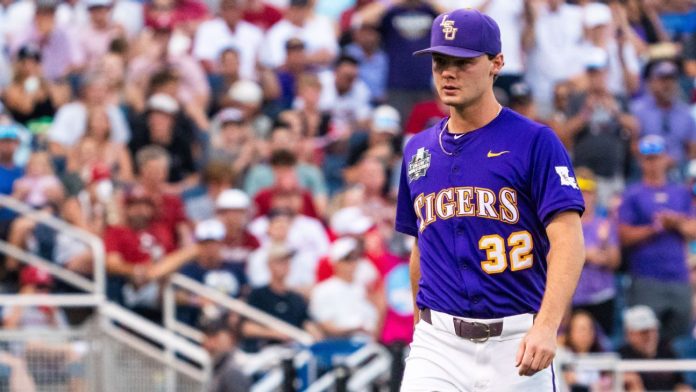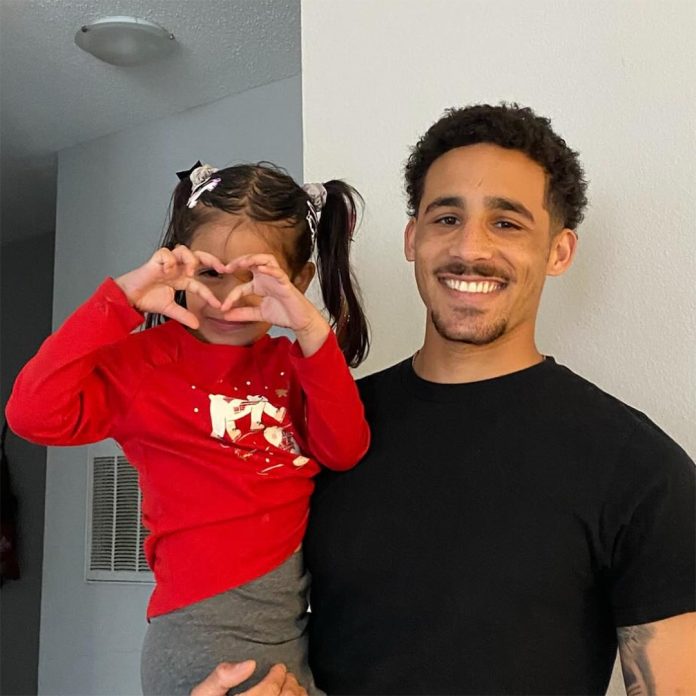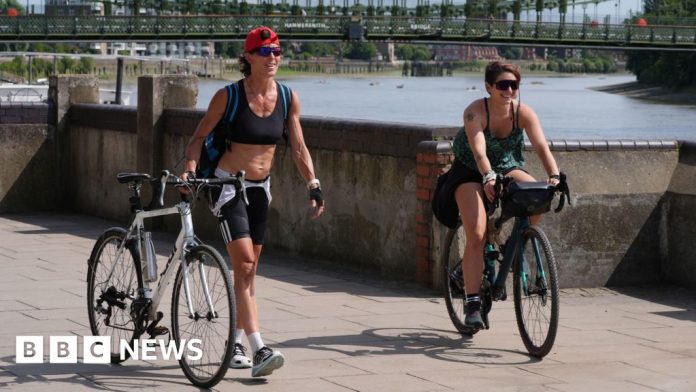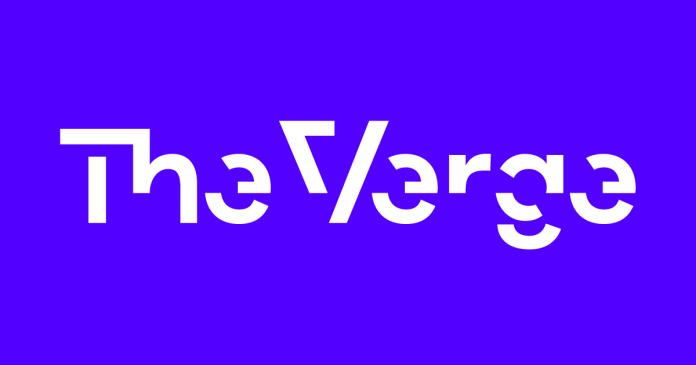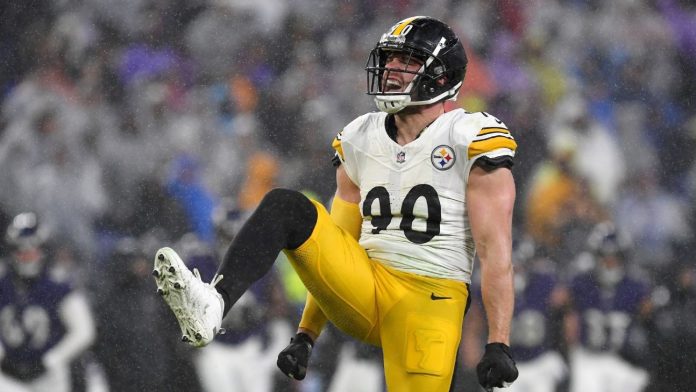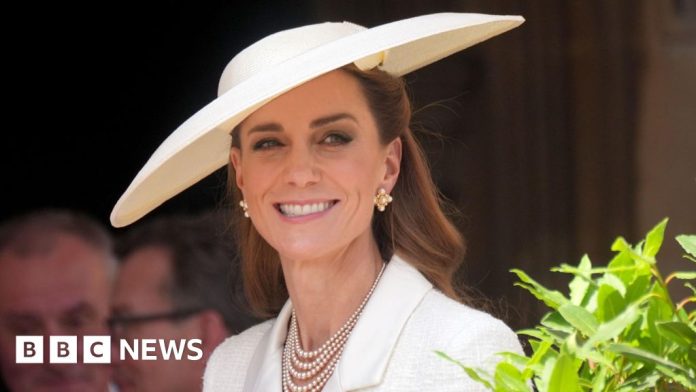With the combine underway and only a few more games in Omaha remaining, MLB draft season is winding down — so it’s time to take another stab at projecting the first round-plus of the 2025 draft.
The start of the MLB draft combine has become a sign that we’re about to enter silly season, when rumors become less attached to reality by the day. Private on-field workouts for players mentioned below are over, so there won’t be much more useful information collected — and that means the rumors are tied to controlling perception, more than reflecting a new reality.
The biggest trend to note compared to the previous mock are the half-dozen or so rising college position players, which also corresponds to rumblings that the second cut of high school position players might slip a bit, often for overslot bonuses.
My “speculative” projection in the last mock was Arkansas right-hander Gage Wood at No. 17 — I thought he could be this year’s Cade Horton or Ty Floyd, rising late through the college postseason. Well, Wood threw a no-hitter earlier this week in the Men’s College World Series and now looks to have a floor somewhere in the range I initially projected him in — which was high at the time.
Now let’s predict the first 40 players to come off the board when this year’s MLB draft starts on Sunday, July 13.

Kade Anderson, LHP, LSU
Top 150 rank: 7
The conversation around who will go No. 1 continues to be wide open and will be until draft day, but Anderson’s strong finish to the season has him looking like the slight favorite over Ethan Holliday as the top pick. Seth Hernandez and Eli Willits are also getting looks here, and I’m sure there are internal conversations about a couple of other options, but Anderson and Holliday are seen as the most likely selections.

Liam Doyle, LHP, Tennessee
Top 150 rank: 6
Name a player, and they’ve probably been connected to this pick. Trying to figure out what’s actually going on here has been like watching “Tinker Tailor Soldier Spy” — there are more outgoing calls, workouts, rumors, misinformation and theories about the second pick than any other in the entire first round.
When in doubt, judge a team based on what it has done, and the Angels like to save on a quick-moving college player with their first pick. Despite his excellent season, Doyle’s interest seems to have a major hole in it. While there’s believed to be real interest in him at No. 2, teams picking behind the Angels think Doyle could slide all the way to No. 9 of No. 10. Both Doyle and Hernandez have a similar group of teams on them, as they’re both seen as a riskier type of pitcher (though not in the same way) than Anderson or Jamie Arnold.
There’s some buzz that prep shortstop Eli Willits could be the pick here (his father Reggie played for the Angels), breaking the Angels’ trend of taking college players, but I’ll believe that when I see it. Outside of the targets in the top 10 or so picks, the Angels seem to really like Georgia prep shortstop Daniel Pierce, but it’s unlikely he drops to their next pick at 47. At the Angels’ next few picks, potential quick-moving college arms such as Georgia’s Brian Curley, Tennessee’s A.J. Russell and Iowa’s Cade Obermueller make a lot of sense.

Jamie Arnold, LHP, Florida State
Top 150 rank: 1
The Mariners seem to be zeroed in on pitching with Anderson and Arnold being the best fits for them, along with high school pitcher Seth Hernandez if they can stomach taking a prep right-hander this high. In this scenario, I think they just take Arnold. Oregon State shortstop Aiva Arquette is still being scouted for this pick and I’ve heard Ike Irish and JoJo Parker brought up, but they seem to be on the outside looking in right now.

Ethan Holliday, 3B, Stillwater HS (Oklahoma)
Top 150 rank: 3
This is one of the most well-known connections in the draft, and Holliday is likely to go fourth if he doesn’t go first. I’d guess this would be for an overslot bonus, similar to what Colorado did with Charlie Condon last year. Colorado is also tied to Arquette and Kyson Witherspoon, though I think they’d also be looking at whichever of the three college lefties remain if Holliday isn’t available.

JoJo Parker, SS, Purvis HS (Mississippi)
Top 150 rank: 9
This is right about where the consensus starts to open up. Names like Ike Irish, Willits, Parker and Billy Carlson come up here, and this is seen as a stopping point for Holliday, Anderson and Arnold if they get this far. Wake Forest shortstop Marek Houston’s name has also come up. If Anderson, Arnold and Holliday are gone, this pick is seen as likely to be a position player — probably the one the Cards think has the best hit tool of the group. Parker would most likely come with some (but not a lot of) savings if he went here and, of late, he has momentum to sneak ahead of Carlson and/or Willits. Some teams think Parker is actually the best hitter in the draft.

Aiva Arquette, SS, Oregon State
Top 150 rank: 8
The two players most tied to this spot are Arquette and Billy Carlson. I’ve also heard the Pirates would take prep righty Seth Hernandez if the board falls a certain way. There are some parallels to Hernandez in other picks this front office has made, like Jared Jones and Bubba Chandler, so it makes some sense.

Eli Willits, SS, Fort Cobb-Broxton HS (Oklahoma)
Top 150 rank: 2
Willits has some interest at the top two picks, and then is in the mix for basically every pick starting at No. 5 with the Cardinals — so he should go by this pick or the next (Toronto). Miami is tied almost solely to prep position players –Willits, Parker and Carlson come up a lot. There have also been some rumors of another underslot deal like last year’s pick of P.J. Morlando, with targets like some of the prep hitters who are projected a dozen picks or so later, if Miami doesn’t like the names/prices of the players on the board.

Ike Irish, C/OF, Auburn
Top 150 rank: 26
Irish will be ranked higher once I update my rankings, and his name is coming up a lot in the back half of the top 10 and into the teens. There’s lots of buzz he will go ahead of Jace Laviolette — and not that far behind Arquette, if not ahead of him. College bats are rumored to be rising late in the process this year (including Brendan Summerhill, Gavin Kilen, Wehiwa Aloy, Marek Houston, Caden Bodine and Andrew Fischer), and moving a high school player who’s a late-first-round talent to a later pick is a common and often successful strategy. Toronto is often tied to the same prep bats as Miami and St. Louis, but the Blue Jays are believed to be going the college route if the right names with the right prices don’t land here. Irish, Arquette, Willits, Parker and Carlson seem like the group from which they’ll probably pick.

Seth Hernandez, RHP, Corona HS (California)
Top 150 rank: 4
Hernandez, as mentioned above, is seen as likely to either go No. 3 to the Mariners or here — with some chance he goes at a couple of other slots, but half the teams in the top 10 seem unlikely to take a prep right-hander. The Reds are hoping he gets here and have no fear of taking this kind of player. If Hernandez isn’t available, they are tied to toolsy types, mostly high schoolers: Steele Hall, Jace Laviolette and Billy Carlson come up the most. This is about where Josh Hammond’s range begins, but he could also go in the 20s.

Billy Carlson, SS, Corona HS (California)
Top 150 rank: 5
The White Sox are casting a wide net because of where they pick. I think Doyle — and probably Carlson and Parker, too — stops here if he happens to slide this far, while Hall is also in the mix. The top tier of talent in the eyes of most evaluators is at least eight players and maybe as many as a dozen, so Chicago will have to be reactive to who is left over. But the White Sox probably will get one of the players they target from that tier.

Brendan Summerhill, CF, Arizona
Top 150 rank: 27
This is about where the top college righties — Kyson Witherspoon and Omaha hero Gage Wood — come into the mix. This is also where that second cut of college position players, with Arquette and Irish gone in this scenario, start to come into consideration depending on what a team prefers: shortstops Wehiwa Aloy, Gavin Kilen and Marek Houston and outfielders Brendan Summerhill and Jace Laviolette. The A’s have been tied to Summerhill all spring, and he probably goes in this range and fits the type of player they’ve taken in the past. He’ll also move up in my rankings in the next update.

Steele Hall, SS, Hewitt-Trussville HS (Alabama)
Top 150 rank: 11
Texas is right in the middle of Hall’s range and I think his most likely landing spot. The Rangers are probably straddling the line between picking up a top-tier player who might get to this spot and leading off the next tier of players, which will lean more toward prep prospects and upside. I think Hall is the last position player in that top tier. Texas is also one of the teams most in on New York prep catcher Michael Oliveto, who has interest as high as the comp round, and could be the team’s second-round pick.

Kyson Witherspoon, RHP, Oklahoma
Top 150 rank: 10
Witherspoon has some landing spots in the top 10, but Arkansas’ Wood is closing in on him as the top college righty. I think both will land just outside of the top 10. The Giants have been tied to many of the aforementioned second cut of college players, with Aloy and Houston also coming up a lot, and Irish quite similar to recently traded former first-rounder James Tibbs.

Gavin Kilen, SS, Tennessee
Top 150 rank: 24
The Rays are tied to the top prep position players, as usual, with Hall, Jaden Fauske, Sean Gamble, Dean Moss and Josh Hammond mentioned the most — though there are also some college players tied to this pick, with Kilen leading the pack. The Rays pick again at Nos. 37 and 42, and there’s a chance most of those prep players will still be around for an overslot bonus, so grabbing a rising college bat that should go by the 20th pick is a good strategy.

Gavin Fien, 3B, Great Oak HS (California)
Top 150 rank: 13
I’m a big believer in Fien, and he fits around here or in the next half-dozen picks or so. The Red Sox were also heavy on Kilen out of high school, or I could see them being swayed by Wood’s outstanding close to the college season.

Gage Wood, RHP, Arkansas
Top 150 rank: 21
I was high on Wood’s upside early on, having him go to the Cubs at the next pick in the last mock I did. After his historic MCWS performance, I think the consensus is he belongs in this general area, maybe as high as Nos. 12 or 13, but probably gone by 20 or 24. Wood, for the right team, could be rushed to the upper level of the minors for a potential big league look in relief as a way to limit his innings but also develop his pitchability against better hitters. Minnesota is mostly tied to college players here and that’s who should be going in this range, though they’re also in on prep third baseman Xavier Neyens.

Wehiwa Aloy, SS, Arkansas
Top 150 rank: 14
Aloy could go a half-dozen picks higher or even a bit lower than this, as the college bats in this tier are seemingly in a different order for every team. Wood still makes sense here, too, especially as a potential quick mover, along with other power bats such as Jace Laviolette, Neyens, Andrew Fischer, Josh Hammond and Tate Southisene.

Marek Houston, SS, Wake Forest
Top 150 rank: 15
The Diamondbacks tend to look for contact-oriented types who fit at up-the-middle positions with their high picks. College players Caden Bodine, Houston and Kilen, as well as high schoolers Slater de Brun, Daniel Pierce and Kayson Cunningham all fit here and at their next pick, No. 29.

Jace LaViolette, CF, Texas A&M
Top 150 rank: 9
Many think Laviolette’s slide would end here given Baltimore’s history of taking power-and-patience-types with some defensive value. Neyens is also commonly connected to the Orioles here, among other position players being named at the picks in this range. But a number of those high school players could get floated to Baltimore’s next picks at 30 and 31.

Caden Bodine, C, Coastal Carolina
Top 150 rank: 35
Bodine’s range starts in the middle of the round with numbers-oriented teams being on him most due to his contact rates and framing prowess, both attributes that Milwaukee emphasizes. Lots of contact-oriented bats are tied here, such as Kilen, Houston, de Brun and Pierce. I could also see this being a possible floor for Wood.

Xavier Neyens, 3B, Mount Vernon HS (Washington)
Top 150 rank: 19
Houston has been tied to a number of the standout athletic testers in the prep class such as Neyens, Southisene, Hammond and Gamble. I could also see this being a floor for power-oriented college bats such as Laviolette and Aloy, with some overlap between the Astros’ targets and who the Orioles take at No. 19.

Tyler Bremner, RHP, UC Santa Barbara
Top 150 rank: 28
Bremner has been a bit disappointing this season but has now fallen enough that he’s a strong value for a team to get in the 20s with a number of landing spots throughout the comp round. I think this Braves pick will be a nice landing spot for college talent with Houston, Wood and Bodine mentioned here.

Josh Hammond, 3B, Wesleyan Christian HS (North Carolina)
Top 150 rank: 18
Hammond has a number of potential landing spots starting around No. 10 and ending somewhere in the mid-20s. Given Hammond’s two-way exploits, there are parallels here with Austin Riley, a player that Royals scouting director Brian Bridges drafted while with Atlanta. I’d expect prep pitching and/or a prep shortstop (lots of names are mentioned, especially given Kansas City’s history) at their next few picks.

Andrew Fischer, 3B, Tennessee
Top 150 rank: 53
Fischer is rising due to his strong performance in the SEC this year, and while he’s likely still behind Irish, he might be sneaking up on Laviolette with a chance to go in the top 20 picks. I think Detroit is looking to pair a college player with a high school player between this pick and its next (34) and will be looking mostly at left-handed hitters. As you can guess, that means a lot of different players have been tied to these two picks. Slater de Brun, Cam Cannarella, Fauske and Kayson Cunningham come up the most.

Slater de Brun, CF, Summit HS (Oregon)
Top 150 rank: 16
De Brun is believed to be in play for Arizona at No. 18 but otherwise probably lands somewhere in the 20s. The Padres are tied to a number of high school players here — Dax Kilby, Quentin Young, Kruz Schoolcraft and Matthew Fisher, among others — but also seem to be in on some college players such as Ethan Conrad and Bremner. I’d predict they go with a high schooler, especially given their history.

Sean Gamble, 2B, IMG Academy (Florida)
Top 150 rank: 23
The Phillies are considering some high school players with upside, as you’d expect, and if the board plays out this way, Gamble, Pierce or Cunningham all fit. There’s a good shot they would look to pair this pick with a prep arm at their next pick.

Tate Southisene, SS, Basic HS (Nevada)
Top 150 rank: 22
I think the Guardians will be in on what’s left of the upside prep position player crop along with being opportunistic if a college player such as Fischer, Wood, Bodine or Bremner falls this far.
Prospect promotion incentive picks
28. Kansas City Royals: Daniel Pierce, SS, Mill Creek HS (Georgia)
Compensation picks
29. Arizona Diamondbacks: Kayson Cunningham, SS, Johnson HS (Texas)
30. Baltimore Orioles: Cam Cannarella, CF, Clemson
31. Baltimore Orioles: Dax Kilby, SS, Newnan HS (Georgia)
32. Milwaukee Brewers: Jaden Fauske, OF, Nazareth Academy HS (Illinois)
Competitive balance picks
33. Boston Red Sox: Luke Stevenson, C, North Carolina
34. Detroit Tigers: Aaron Watson, RHP, Trinity Christian HS (Florida)
35. Seattle Mariners: Ethan Conrad, RF, Wake Forest
36. Minnesota Twins: Charles Davalan, LF, Arkansas
37. Tampa Bay Rays: Anthony Eyanson, RHP, LSU
These three teams had their first-round picks moved down 10 slots due to exceeding the second surcharge threshold of the competitive balance tax. We’ll include them so all 30 teams have a projected pick.

Devin Taylor, LF, Indiana
Top 150 rank: 57
Taylor has a lot of interest in the comp round and doesn’t have an enormous upside, but he could be quick moving with 55-grade hit and power grades.

J.B. Middleton, RHP, Southern Miss
Top 150 rank: 50
Middleton has a lot of interest from a late-first to an early second-round pick as a power arm with starter feel and gaudy numbers this spring. He’s similar as a prospect to two top picks in last year’s draft, college righties Ben Hess and Bryce Cunningham.

Quentin Young, SS, Oaks Christian HS (CA)
Top 150 rank: 101
Young, the nephew of Dmitri and Delmon Young, is tied to the Dodgers and Padres and has lots of late momentum despite his high whiff rates in the spring and last summer. That’s due to his gargantuan upside as a 6-foot-6 infielder with plus-plus raw power that might be 80-grade one day; he’ll be moving up in the update of my top 150 rankings. The Dodgers also have the 41st pick and while I have them tied to a number of arms, I landed on Louisville’s Patrick Forbes.

